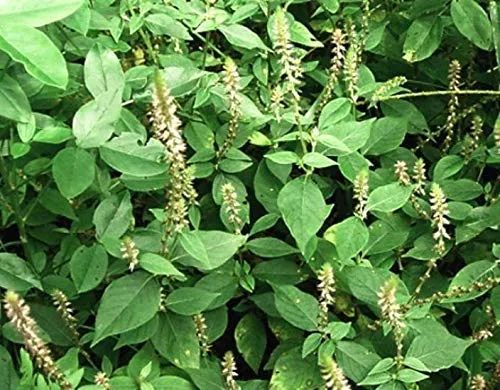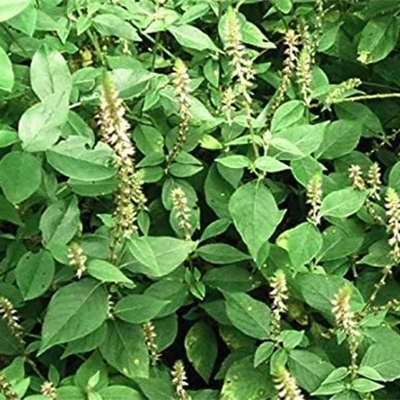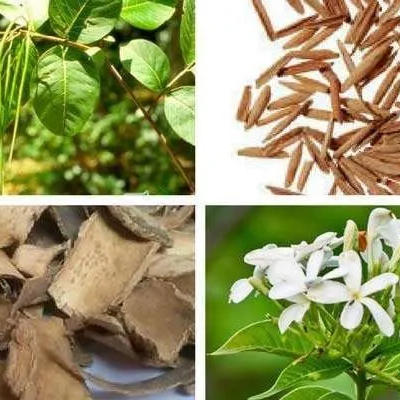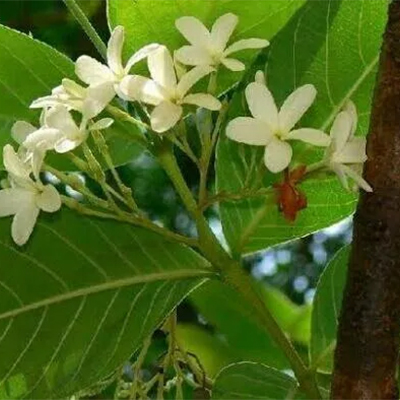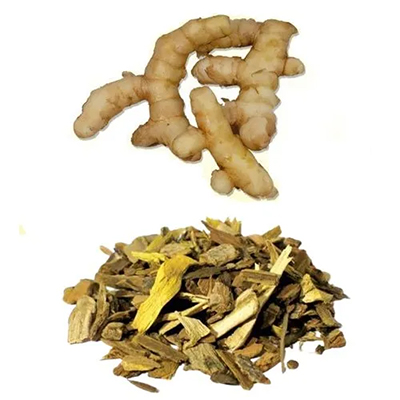On This Page
Apamarg (Achyranthes aspera) – Uses and Benefits
Introduction
Apamarga is a weed that grows throughout the tropical parts of the world including India. Botanically Apamarga is known as Achyranthes aspera and is popular with the English name prickly chaff flower. Apamarga has various medicinal uses, and it has been used right from the Vedic Period. In Atharva Veda, Apamarga is said to be Yathudhan Krimi Nashaka and Kshetriya Roga Nashak. As Apamarga possesses Rakshoghna properties therefore in Yajur Veda Veda Kaal it is used for Havana purpose. Apamarga possesses hundreds of properties due to which it cures various diseases and increases life span since ancient times therefore known as Lord of all plants. As per Ayurveda Apamarga mitigates Kapha, is cold in potency, and causes dryness. In Ayurveda, Apamarga is famous for preparing Kshara (caustic ash) which is used to treat various ailments. Recent research revealed that Apamarga possesses various properties like anti-inflammatory, anti-diabetic, abortifacient, etc.
Basonym of Apamarga
अपाकृत्य दोषान शरीरं मार्जयति शोधयति, यथोक्तं शौनकीयाथर्वेदे अपामार्ग त्वया वयं सर्वं तदपमृज्महे इति।
The plant which removes all the vitiated Doshas from the body and purifies the body.
Synonyms of Apamarga
- According to morphology:
खर मंजरी – कंटकि त्वात खर स्पर्श पुष्प मंजरी।
The inflorescence has spinous bracteoles and pointed perianth, hence prickly to touch.
अधः शल्य – कंटकि पुष्पाणाम माधो मुख त्वात।
Spinous bracteoles and pointed perianth.
दुर्ग्रहा – कंटकि त्वात ग्रहितुम कष्टा।
Difficult to hold as the inflorescence is spinous.
शिखरि – शिखरे पुष्प मञ्जरी त्वात।
Bears terminal spike inflorescence.
प्रत्यक पुष्पा – प्रत्यंचि अधो मुखानि पुष्पाणयस्य।
Deflexed flower.
- According to action and properties:
मार्गः – मजियति मार्गान स्त्रोतांसिति।
Cleanses all the channels.
क्षारमध्य: – क्षारो मध्ये गात्रे अस्य औषधे: क्षार प्रधानत्वात।
Whole plant is predominantly alkaline.
मयूरकः – मयूर इव विषघ्न: अथवा मीनाति हिनस्ति रोगान।
It is anti-poisonous or cures many diseases.
क्षवक: – क्षवथु करः अपामार्ग तंडुलनां शिरो विरेचक त्वात।
Cause sneezing, the seeds possess Shiro Virechaka properties.
Regional Names of Apamarga
- Devil’s Horsewhip, Chaff-Flower, Prickly Chaff Flower (English)
- Chirchita, Chirchira, Latjira, Onga (Hindi)
- Uttatane (Kannada)
- Uttatene (Konkan)
- Katalati (Malayalam)
- Aghada (Marathi)
- Khare-Vazhun (Persian)
- Kutri (Punjabi)
- Nayurivi (Tamil)
- Uttareni, Antisha (Telugu)
Botanical Name
Achyranthes aspera Linn.
Achyranthes is derived from the word Akanthes which means thorn.
Aspera refers to spinous bracts of inflorescence.
Family
Amaranthaceae (Apamarga Kula)
Ayurvedic Reference for Apamarga (Achyranthes aspera Linn.)
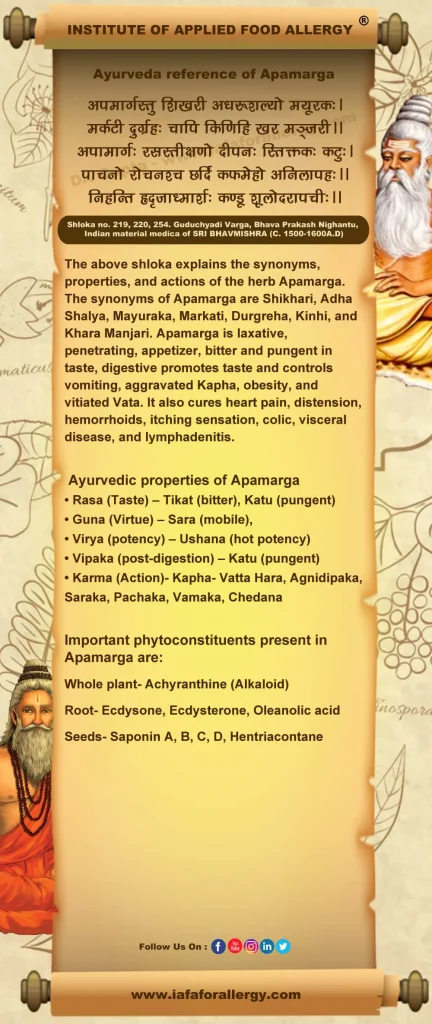
Scientific Classification of Apamarga
| Kingdom | Plantae |
| Class | Dicotyledons |
| Subclass | Monochlamydae |
| Series | Curvembryae |
| Family | Amaranthaceae |
| Genus | Achyranthes |
| Species | aspera |
Classification of Apamarga – As Per Charaka and Sushruta
- Charaka: Krimighana Mahakshaya, Vamanopaga Mahakshaya, Shirovirechana Mahakshaya
- Sushruta: Arkadi Gana
Apamarga’s Description in Brihtrayi
| Charaka | Shusruta | Vagbhata
(Ashtang Hridya) |
| C. S. Su. 2/ 2, 32 | S. S. Su. 11/ 11 | A. H. Su. 10/ 29 |
| C. S. Su. 4/ 27 | S. S. Su. 16/ 20, 27 | A. H. Su. 15/ 4 |
| C. S. Vi. 7/ 20 | S. S. Su. 36. 31 | A. H. Su. 30/ 10 |
| C. S. Vi. 8/ 158 | S. S. Su. 39/ 6 | A. H. Sa. 1/ 39 |
| C. S. Sa. 8/ 28 | S. S. Su. 42/ 18 | A. H. Sa. 3/ 127, 133 |
| C. S. Chi. 7/ 123 | S. S. Chi. 4/ 32 | A. H. Sa. 5/ 79 |
| C. S. Chi. 8/ 175 | S. S. Chi. 6/ 13 | A. H. Sa. 8/ 160 |
| C. S. Chi. 9/ 72 | S. S. Chi. 7/ 22 | A. H. Sa. 11/ 31 |
| C. S. Chi. 10/ 17, 42 | S. S. Chi. 14/ 12 | A. H. Sa 15/ 46 |
| C. S. Chi. 13/ 169 | S. S. Chi. 17/ 18, 25 | A. H. Sa 19/ 86 |
| C. S. Chi. 17/ 125 | S. S. Chi. 25/ 26 | A. H. U. 1/ 47 |
| C. S. Chi. 18/ 56 | S. S. Ka. 6/ 12 | A. H. U. 3/ 45 |
| C. S. Chi. 23/ 243 | S. S. Ka. 8/ 54, 106 | A. H. U. 7/ 20 |
| C. S. Chi. 26/ 183 | S. S. Sa. 10/ 45 | A. H. U. 9/ 29 |
| C. S. Si. 9/ 63 | S. S. U. 52/ 42 | A. H. U. 22/ 63 |
| C. S. Si. 12/ 24 | S. S. U. 61/ 34 | A. H. U. 24/ 10 |
| A. H. U. 37/ 73 |
External Morphology of Apamarga
- Habit- Apamarga is a wild perennial herb, which grows 30-90 cm in height.
- Root- Its roots are branched, taproot.
- Stem- Aerial erect, angular, branched, hairy, green, herbaceous but woody below. Nodes and internodes in the stem are prominent and are violet or pink at nodes.
- Leaf- Leaves of Apamarga are petiolate, opposite, simple, obovate, or semi- orbicular with a suddenly pointed apex; hairy, reticulate venation.
- Inflorescence- A spike with reflexed flowers arranged on a long peduncle.
- Flower- Bracteate, bracteolate, and bracteoles have spinous tips, complete, actinomorphic, bisexual, hypogynous, pentamerous, tetracyclic, small, green, and spinescent.
- Perianth- Tepals 5, valvate, persistent, ovate to oblong, green, membranous, and chaffy.
- Androecium- Stamens 10, 5 fertile stamens, alternating with 5 sterile.
- Gynoecium- Bicarpellary syncarpous and ovary are superior.
- Fruit- An indehiscent achene enclosed within persistent perianth and bracteole.
- Seed- Endospermic
Flowering and Fruiting Time of Apamarga
Flowering in winter and fruiting in summer.
Varieties/ Types of Apamarga
The reference to ‘Gouradanda Apamarga’ by Vagbhata (A.H.Sha. 1/39) indicates another variety of Apamarga in the Samhitas. All the Nighantu writers described two kinds of Apamarga i.e.
- Shweta (white) varieties
- Rakta (red) varieties
Kaiyadeva mentioned three varieties i.e.
- Apamarga (white)
- Vasira (red)
- Ramatha (blue)
bidentata Blume is another species belonging to the genus Achyranthes which is in vogue for its medicinal value.
Distribution of Apamarga
Apamarga grows throughout the warmer and tropical regions of the world as a weed. Apamarga is found in India in the Shivbari sacred grove of Himachal Pradesh, Distt. Lalitpur of Uttar Pradesh. Globally it is found in Asia as well as America, Africa, Europe, and Australia. Apamarga was reported as an invasive alien species in northern Bangladesh.
The Useful Part of Apamarga
Whole plant.
Dry herb, consisting of pieces of quadrangular, striated stems, 4 to 7 mm in diameter, orbicular, obovate, hairy leave, having an attenuated base and short petiole and pieces of long slender spikes bearing prickly flowers or fruits which are sharply deflexed against the rachis. The color of fleshy dried material is grayish which changes to pale brown during storage, and has a faintly aromatic odor and bitter taste.
Important Phytoconstituent of Apamarga
- Whole plant- Achyranthine (Alkaloid)
- Root- Ecdysone, Ecdysterone, Oleanolic acid
- Seeds- Saponin A, B, C, D, Hentriacontane
Recent Research on Apamarga
- Anti-asthmatic activity
- Anti-cancer activity
- Antimicrobial activity
- Anti-diabetic activity
- Diuretic activity
- Hepatoprotective activity
- Antioxidant activity
- Anti-arthritic activity
- Cardiovascular diseases
- Immune-modulatory activity
- Pro-thyroid activity
- Laxative
- Anti- plasmonic
- Ecbolic
- Diuretic
- Antihypertensive
- Spasmolytic
- Purgative
- Anti- leprotic
Rasa-Panchaka (Properties) of Apamarga Panchang (Whole Plant)
| Rasa (Taste) | Tikat (bitter), Katu (pungent) |
| Guna (Virtue) | Sara (mobility), Teekshana (sharp) |
| Virya (potency) | Ushana (hot potency) |
| Vipaka (post-digestion) | Katu (pungent) |
| Dosha Karma (action on Dosha) | Kapha- Vata Hara because of its Ushana Virya |
Rasa-Panchaka (Properties) of Apamarga Phala (Fruit)
| Rasa (Taste) | Madhura (sweet) |
| Guna (Virtue) | Ruksha (dry) |
| Virya (potency) | Sheet (cold potency) |
| Vipaka (post-digestion) | Madhura (sweet) |
| Dosha Karma (action on Dosha) | Vatakara because of its Sheeta Virya |
Karma of Apamarga
Agnidipaka, Saraka, Pachaka, Vamaka, Chedana
Prayogarha Vyadhi (Therapeutic Indication) of Apamarga
- Agnimandya
- Arsha
- Apachi
- Adhmana
- Kandu
- Dadru
- Chardi
- Udarshool
- Hridruja
- Udara Roga
Aamyik Prayog (Therapeutic Uses) of Apamarga
Arsha (Piles): Repeated administration of Apamarga Mula (root) grinded with Kshodra (honey) given with Tandulodak is very useful in Arsha. (Shusruta Samhita Chikitsa Sthana. 6/ 13)
Vishuchika (Diarrhea): Apamarga Mool (roots) and Kalka (paste) taken with water is efficacious in Visuchika. (Bhava Prakasha Chiktsa 6/ 110)
Rakta- Arsha (Bleeding piles): In bleeding piles, seeds of Apamarga taken with rice water are very useful. (Sharangdhara Samhita. 2/ 5/ 19)
Nadi Vrana (Sinus): Oil prepared out of Apamarga Phala is applied along with cow’s urine in Nadi Vrana. (Sushruta Samhita Chiktsa Sthana 17/ 25)
Atyagni (Bhasmaka): In excessive hunger, gruel prepared out of Apamarga Bija (seed), and milk with Godha Rasa (iguana meat juice) is effective. (Charaka Samhita Sutra Sthana 2/ 33)
Shastra Kshata (wound): Paste of Apamarga leaves is applied over accidental wound to check to bleed. (Chakra Dutta. 44/ 52)
Siddha (skin disorder):
- Radish seeds pounded with the juice of Apamarga or with Kadali Kshara mixed with Haridra and applied to the part that destroys Sidhma. (Vrindha Madhava. 51/ 17)
- Sidhma is also destroyed by the application of Apamarga ash. (Vaidya Manorma. 11. 60)
Ashmari (Gravels and stone): Alkali made of Tila, Apamarga, Kadali, Palasha, and Yava should be taken with sheep urine in gravels and stones. (Ashtanga Hridya Chiktsa Sthana. 11/ 31)
Mutrakricha (Dysuria): Apamarga root taken with milk overcomes dysuria. (Vaidya Manorma. 7/ 4)
Kashta Prasva (Difficult labor):
- The root of Apamarga should be introduced and kept in the vagina. It induces labor easily. (Vang Sena, Striroga, 233)
- The paste of Apamarga root applied on the navel, pelvis, and vulva acts similarly. (Gada Nigreha. 6. 4. 23)
Vrana (Wounds):
- Apamarga, Asvagandha, Talapatri, Suvarcala, and the drugs Kakolyadi Gana are recommended for the elevation of the wound. (Sushruta Samhita Sutra Sthana. 37/ 30)
- Apamarga is the first drug listed along with other drugs- Aragvadha, Nimba, Koshataki, Tila, Brhati, Kantkari, Haritala, and Manshila as Sodhana (purifier) for wounds to be used in Sodhana Taila. (Sushruta Samhita Sutra Sthana. 37. 17- 18)
Sinuses:
- Oil is prepared with the fruits of apamärga along with (cow) urine and applied to the sinus. (Sushruta Samhita Chikitsa Sthana. 17/ 25)
- Sesamum pounded with fruits of Apamarga and applied as the paste is also useful. (Vrinda Madhava. 47/ 2)
Accidental wounds:
- Apamarga mool is cooked with Taila (Oil) along with water i.e Apamarga- Taila applied locally(Stanika) to relieve pain (Shool) caused by accidental injuries. (Raja Amritanda. 26. 7)
- The paste of Apamarga Patra (leaves) applied locally checks hemorrhage. (Vaidya Manorma. 16/ 120; Chakradutta. 44/ 42)
Akshi Roga (Eye disease):
The root of Apamarga rubbed in a copper vessel with rock salt and curd water and applied locally alleviates inflammation in the eye. (Gada Nigreha. 3. 3. 366)
Karna Roga (An ear disease): Apamarga Kshara Taila (oil cooked with alkali-water and paste of Apamarga) alleviates tinnitus and deafness by instilling in the ear. (Vrinda Madhava. 59/ 25)
Shiro Roga (Head disease): Massage with oil cooked with Apamarga fruits removes all types of pain in the head. (Gada Nigreha 3. 1. 125)
Shav Dansha (Dog-bite): Juice of (the leaves of) Apamarga is applied to the wound. (Ashtanga Sangreha Uttar Tantra. 46/ 64)
Atya- Aartava (Meno-metrorrhagia): Sprinkling of Apamarga juice on the head checks excessive bleeding. (Gada Nigreha .6. 1. 54)
Udara Shool (Abdominal pain): Ghee cooked with a decoction of Apamarga and paste of Pippali destroys abdominal pain. (Sashtra Yogam. Ghrta. 5)
Kamala (Jaundice): Roots of Apamarga and Shami 10 gm are pounded and administered with buttermilk. It alleviates jaundice, edema, and anemia. (Ras Ratna Samucchaya. 19. 109)
Anidra (Insomnia): Decoction of Kakajangha, Apamarga, Kokilaksa, and Suparnika induces sleep. (Harita Samhita. 3. 15. 6)
Yoni Shool (Pain in Vagina):
- A pair of leaves of Apamarga introduced into the vagina relieves pain instantaneously. (Gada Nigreha. 6. 6. 15)
- Application of the paste of the roots of Apamarga and Punarnava removes vaginal pain during puerperium. (Vrinda Madhava. 13. 40)
Important Benefits of Apamarga
- Cough (Kasa): Apamarga helps to break down the excessive mucus in the respiratory tract as it is a potent cold clearer. Thus, provides relief from frequent bouts of cough.
- Animal bites (Dansha Visha): Apamarga possesses anti-poison properties due to which it acts as a potent remedy for scorpions (Vrishika Dansh Visha), snakes (Sarpa Visha), dogs (Shav Visha).
- Difficulty in urine (Mutra Kricha): Apamarga possesses diuretic properties which help to relieve the problem of difficulty in passing urine. It also helps to cure various other kidney problems.
- Clear cholesterol deposits from the heart (Hridya): Apamarga is considered Hridya and also it helps to remove excess cholesterol from blood vessels that disturb the blood circulation.
- Gastric disorders (Udara Vikara): Apamarga with its properties help to remove Ama (toxins) from the body, improve digestive health, and relieve various gastric disorders like bloating, colic pain, etc.
Matra (Therapeutic Administration and Dosage) of Apamarga
- Kshara (caustic ash) – 0.5 to 2 grams
- Swarasa (juice) – 10- 20 ml
- Mula Churna (root powder) – 3- 6 grams
- Bija Churna (seed powder) – 3 grams

Have A Health Issue?
Consult Online
- Dr. Sahil Gupta (B.A.M.S., M.H.A.)
Ayurvedic Allergy Specialist
CEO & Founder of IAFA®
Classical Reference of Apamarga
Bhava Prakasha Nighantu Guduchyadi Varga- 219
Synonyms
अपमार्गस्तु शिखरी अध:शल्यो मयूरकः |
मर्कटी दुर्ग्रह: चापि किणिहि खर मञ्जरी।।
Bhava Prakasha Nighantu Guduchyadi Varga- 221
रक्तो अन्यो वशिरो वृत्तफलो धामार्गवो अपि च ।
प्रत्यक पर्णी केशपर्णी कथिता कपिपिप्पली ।।
Bhava Prakasha Nighantu Guduchyadi Varga- 220
Properties and action of Apamarga
अपामार्ग: रसस्तीक्षणो दीपन: स्तिक्तक: कटु: ।
पाचनो रोचनश्च छर्दि कफमेहो अनिलापह: । ।
निहन्ति हृदृजाध्मार्श: कण्डू शूलोदरापची: ।।
Bhava Prakasha Nighantu Guduchyadi Varga- 254
अपामार्गस्तु तिक्तोष्ण: कटुश्च कफनाशन: ।
अर्श: कण्डूदरामघ्नो रक्तहददग्राहिवान्ति कृत् ।।
Kaideva Nighantu Aushadhi Varga, 1033- 1034
अपामार्ग: कटुस्तिक्तस्तीक्ष्णोष्णी दीपन: सर: ।
पाचनो वामनछेदी कफमेदो अनिलापह: ।
निहन्ति शूलहिध्माशोकण्डू दद्रुरापची: ।।
Bhava Prakasha Nighantu Guduchyadi Varga- 222
Rakta Apamarga
अपामार्गो अरुणो वात कफहदहिम: ।
रुक्ष: पूर्व गुणे न्यूनः कथितो गुणेविदिभिः।।
Bhava Prakasha Nighantu Guduchyadi Varga- 223
Apamarga Phala (fruit)
अपामार्ग फलं स्वादु रसे पाके च दुर्जरम ।
विष्टम्भी वातलं रुक्षं रक्तपित्त प्रसादनम् । ।
Priya Nighantu Shatpushpadi Varga- 179
अपामार्ग बीजानि युज्यन्ते नस्य कर्मणि |
तत्पायसं हितं विद्याद गदे भस्मसंज्ञके ।
Kaideva Nighantu Aushadhi Varga- 1038
रामठ: कटुकः शोफकफमारूतनाशनः ।।
Shounak. 4/ 17/ 7
अपामार्ग त्वया वयं सर्व तद॒प मृज्महे ।
अप (हत्य दोषान् शरीर) मृज्यते अनेन इति अपामार्ग: ।
Saayana
प्रत्यंग मुखानि फलानि अस्य। अग्रादारभ्य फलस्य मूलपर्यन्त॑ आत्माभिमुखं स्पर्शने कंटकरा हित्य दर्शनात प्रतीचीनफलत्वं ।
Charaka Samhita Sutra Sthana. 25
प्रत्यक पुष्पा शिरोविरेचनानाम् ।
Charaka Samhita Sutra Sthana. 25
अपामार्गस्य बीजानि शिम्रूणि मरिचानि च …….. ।
Dhanantri Nighantu
अपमर्गस्तु प्रत्यक्पुष्पी मयूरक: । अध: शल्यो अथ किणिही दुर्ग्रहा खर मञ्जरी ।।
से चैवोक्त: शिखरिको मर्कटी दुरभिग्रह: । पराक्पुष्पी वशिरश्च कण्टी मर्कटपिप्पली।।
अपामार्ग तिक्तोष्ण: कटुश्च कफनाशन: । आर्श; कण्डू उदर आमघनो रक्तहद्या ग्राही वान्तिकृत्।।
अन्य रक्तो रक्तपुष्पो वशिर: कपि पिपली । क्षुद्र अपमार्जको रक्त: ख्यातको रक्तपूर्वक: ।।
अपमार्गो अरुण: वातविष्टम्भी कफनाशन: । वर्ण कण्डु विषघ्नश्च ब्रसंग्राही वान्तिकृत्पर: ।।
Shodhal Nighnatu
अपामागि तु शिखरी प्रत्यक्पुष्पी मयूरक: ।। अध:शल्यो अथ किणिही कण्टी मर्कटपिप्पली ।
क्षवो अधोमार्कवों घंटा मर्कटी दुरभिग्रह:।। प्रत्यकुश्रेणी च वशिर: कटुशच खरमंजरी।।
अपामागो अग्निकृत्तीष्णो नस्याच्छी्षकृमीन् जयेत्।। वामनो रक्तसंग्राही रक्तातीसारहन्यत: ।
Kaideva nighnatu Aushadhi Varga
अपामार्ग: शैखरिक: शिखरी खरमंजरी । अध:शल्य: क्षारमध्य: दुर्गहो दुरभिग्रह:।।
अघाट: किणिही मार्ग: प्रत्यक्पुष्पी मयूरक: । अपामार्ग: कटु स्तिक्तस्तीकष्णोष्णो दीपन: सर:।।
पाचनो वामनश्छेदी कफमेदो अनिलापह: । निहन्ति शूलहिध्नमाशोकण्डू दद्रु उदरा अपची:।।
अन्यो वृत्तफलो रक्तबिन्दुक: कपि पिपली । वशिरो मर्कटी कुष्ठ: प्रत्यकश्रेणी खरच्छद:।।
समष्ठिल स्तोयवृत्ती रामठस्तोयमंजरी।। उलक: शोषहा तोयापामार्गश्व मयूरक: । रामठ: कटुक: शोफकफमारुतनाशन:।।
Bhava Prakasha Nighnatu
अपामार्गस्त शिखरी हाध:शलयो मयूरक: । मर्कटी दुर्ग्रहा चापि किणिही खर मञ्जरी।।
रक्तो अन्यो वशिरो वृत्तफलो धामार्गवो अपि च | प्रत्येक पुष्पी केशपर्णी कथिता कपिपिप्पली।।
अपमार्गो अरुणो वातविष्ठम्भी कफहद्धिम: ।
Raja Nighantu
अन्यो रक्तो हापामार्ग: क्षुद्र अपामार्ग स्तथा । आघटको दुग्धनिका रक्त बिंदु अल्प पत्रिका।।
रक्त अपमार्गक: शीत: कटुक: कफ वातनुत।
Charaka Samhita Sutra Sthana. 2/ 33
अत्यग्नौ-
शुधं हन्यादपामार्गक्षीरगोधारसै: श्रृता।
Sushruta Samhita Chikitsa Sthana. 6/ 13
अर्शसि
अपामार्गमूलं वा तण्डलोदकेन सक्षौद्रमहरह: ।
Sharanghdhara Samhita. 2. 5. 19
अपामार्गस्य बीजानां कल्कस्तण्डुलवारिणा।
पीतो रक्तार्शसां नाशं कुरुते नात्र संशय: ।।
Vaidya Manorma. 5/ 8
मयूर वल्क किझल्कवरीवासाश्यृतं जलम्।
रक्तार्शसां प्रशमनं स्यात् पलाण्डुरिवाशित: ।।
Siddha Bhaishjya. 4/ 228
कल्कमपामार्गस्य विमिश्रय सुजाततक्रेण ।
Bhava Prakasha Smhita Chikitsa Sthana. 6/ 110
विसूचिकायाम्
जलपीतमपामार्गमूलं हन्याद् विसूचिकाम्।
Vrinda Madhava. 51/ 17
सिध्मे
शिखरिरसेन सुपिष्टं मूलकबीज प्रलेपत: सिध्मम्।
क्षारण कदल्या वा रजनीमिश्रेण नाशयति।।
Vaidya Manorma. 11/ 60
प्रलेपात् सिध्म यात्यस्तमपामार्गस्य भस्मना।
Ashtanga Hridya Chikitsa Sthana. 11/ 31
शर्कराश्मर्यों:
तिलापामार्गकदलीपलाशयवसंभव: ।
क्षार: पेयो अविमूत्रेण शर्करास्वश्मरीषु च।।
Vaidya Manorma. 7/ 4
मूत्रकृच्छे
मूत्रकृच्छ जयेत् पीता क्षीरण शिखरिशिफा।
Vang Sena. Stri Roga. 233
कष्टप्रसवे
अपामार्गशिफां योनिमध्ये निक्षिप्य धारयेत्।
सुखम प्रसूयते नारी भेषजस्यास्य योगत: ।।
Gada Nigreha. 6. 4. 23
मयूरकजटा: पृथक्।
नाभिवस्तिभगालेपात् सुख नारी प्रसूयते।।
Sushruta Samhita Sutra Sthana. 37/ 30
व्रण
अपामार्गो अश्वगन्धा च तालपत्री सुवर्चला।
उत्सादने प्रशस्यन्ते काकोल्यादिश यो गणः।।
मयूरको राज वृक्षो निम्बः कोशातकी तिलाः |
Vrinda Madhava. 47/ 2
नाडी व्रण
प्रत्यक्पुष्पीफलयुतैस्तिलैः पिष्टे प्रलेपयेत।
Raja Amritanda. 26. 7
शस्त्र क्षते
अपामार्ग तैलं।
Vaidya Manorma. 16/ 120
अपामार्गदलालेप: सद्यो बध्नाति शोणितम्। अपामार्गस्य संसिक्त॑ पत्रोत्थेन रसेन वा।
सद्यो वर्णेषु रक्त तु प्रवृत्त परितिष्ठति ।।
Gada Nigreha Netra. 3. 3. 366
नेत्ररोगे
प्रत्यक्पुष्पामूलं ताप्रमयभाजने ससिन्धूत्थम्।
मस्तुसहितं निधृष्ठे नयनोत्कोप॑ हरत्याशु।।
Vrinda Madhava. 59. 25
कर्णरोगे
मार्गक्षारजलेन तत्कृतकल्केन साधितं तिलजम्।
अपहरति कर्णनादं बाधिर्यं चापि पूरणत:।।
Gada Nigreha. 3. 1. 125
शिरोरोगे
तैलं अभ्यङ्गात्।
शिरसो रुज: समग्रा यदि बापामार्गफलसिद्धम।
Ashtanga Sangreha Uttara Tantra. 46/ 64
अलर्कविषे
व्रणस्योपरि निष्पीड्य: प्रत्यक् पुष्प रसो अथवा।
Specific Formulation of Apamarga
- Apamarga Kshara for Arsha
- Apamarga Taila for Krimij Shira Shool
- Apamarga Varti for Yonigata Rakta Strava, Yonivyaapad
- Triphaladi Taila for Apasmara
- Mahapanch Gavya Ghrita for Apsmara, Unmada and Sotha
- Apamarga Kalka for Asrigdara
- Apamarga Ghrita for Shoola
Some other classical formulations that have Apamarga as an ingredient:
- Kushthaghna Yoga
- Jivantyadi churna
- Tila Kshara
- Suvarchika Taila
- Amrit Sarpi
- Agastya Avleha
- Panchagavya Ghrita
Contraindication and Side Effects of Apamarga
- If Apamarga is taken at a Dosage that is more than the recommendation, then it may cause nausea and vomiting.
- Male patients who are under infertility treatment must avoid using od Apamarga for a longer duration.
- Pregnant women, breastfeeding mothers, and children under 12 years of age should use Apamarga under medical supervision.
Suggestive Reading Regarding Apamarga
- Lanjwani, Abdul & Ali, Arshad & Pirzado, Muhammad & Memon, Nazakat & Rahim, Halar & Singh, Dolat. (2021). Proximate composition, phytochemical and mineral content, and biological properties of Achyranthes aspera. 10. 2281-4876.
- Banerjee, Janmajoy & Dahal, Prasanna. (2014). PHYTOCHEMICAL CONSTITUENTS AND PHARMACOLOGICAL USES OF MEDICINAL PLANT ACHYRANTHES ASPERA. World Journal of Pharmaceutical Research. 4.
- Shibeshi W, Makonnen E, Zerihun L, Debella A, Effect of Achyranthes aspera L. on fetal abortion, uterine and pituitary weights, serum lipids and hormones, African Health Sciences, 6(2), 2006, 108-112.
- Prasad S, Bhattacharya IC. Pharmacognostic study of Achyranthes aspera Linn., Indian Journal of Pharmacy, 21(3), 1959, 85.
- Kumar Sharma, A. (2015). MEDICINAL PROPERTIES OF APAMARG (ACHYRANTHES ASPERA LINN.). International Journal of Ayurveda and Pharma Research, 1(3). Retrieved from https://www.ijapr.in/index.php/ijapr/article/view/48
- Rashmi and Dayal R. Fatty acid composition of Achyranthes aspera seed oil. Journal of Oil Technologist’s Association of India. 53-54 (2003).
- Ramesh Londonkar, Chinnappa Reddy V and Abhay Kumar K. potential antibacterial and antifungal activity of achyranthes aspera l.
- Ashwini Kumar Sharma. Medicinal Properties of Apamarg (Achyranthes AsperaLinn.) Research in Science and Technology 3(4): 53-57 (2011)
- Manjula M, Indira V, and Dhasarathan P. Phytochemical characterization and antibacterial activity screening of Achyranthes aspera. Asian J. Microbiol. Biotech. Environ. Sci. 11(2): 365-368 (2009).
- Datir S B, Ganjare A B, Nirmal S A, Bhawar SB, Bharati D K, and Patil M J. Antiallergic activity of the various extracts of the aerial part of Achyranthes Aspera. Pharmacol. online. 921-925 (2009).
- Barua C C, Talukdar A, Begum S A, Buragohain B, Roy JD, Borah R S and Lahkar M. Antidepressant-like effects of Achyranthes Aspera L. animals models of depression. Pharmacol. 2: 587-594 (2009).
- Kavishankar GB, Lakshmidevi N, and Mahadeva Murthy S. Phytochemical analysis and antimicrobial properties of selected medicinal plants against bacteria associated with diabetic patients. International Journal of Pharma and BioSciences. 2(4): 509-518
References
- Agnivesha, Charaka, Dridhabala . In: Charaka Samhita, ed. Vaidya Jadavaji Trikamji Aacharya., editor. Varanasi: Chaukhamba Sanskrit Sansthan; 2009.
- Sushruta. In: Sushruta Samhita, Sutra Sthana, ed. Vaidya Jadavji Trikamji Acharya., editor. Varanasi: Choukhambha Orientalia; 2005.
- Vagbhata. In: Ashtanga Hrudaya, 9th ed. Anna Moreshwar Kunte, Krishnashastri Navarre, Harishastri, editors. Varanasi: Choukhambha Orientalia; 2005.
- Bhavamishra. In: Bhava Prakasha Nighantu, Guduchyadi Varga 11th ed. part 2. Brahma Shankara Mishra., editor. Varanasi: Choukhambha Bharati Academy; 2009.
- Bhavprakasha, commentary by Bulusu Sitaram, forwarded by K.C.Chunekar
- Sharma PV, Kaideva Nighantu. Aushadhi Varga. Chaukhamba Orientalia, Varanasi; 2006:
- Tripathi I., Raja Nighantu, Chaukhamba Krishnadas Academy; Varanasi; 2010
- Dr. Gyanendra Pandey, Dravyaguna Vigyana, reprint 2012, Chwkhamba Krishnadas Academy
- K. Niteshwar Dravyagunavigyana, reprint 2017.
- Priya Nighantu by P. V. Sharma, Chaukhamba Krishnadas Academy; Varanasi
- Dr. J.L.N. Sastry and Dr. B.S. Sastry, Dravyaguna Vigyana, Chaukhambha Orientalia, Varanasi.
- Chakrapanidatta, Chakradatta with the vaidayaprabhahindi commentary by indradevatripathi, chaukambha sankritasansthan, varanai 2nd Edition, 1994.
Ayurveda is an Indian system of medicine that is popular since ancient times. Dr. Gupta’s IAFA® has been conducting research studies to find out different phytoconstituents of herbs and their action in the body. Such knowledge acquired by our experts is used in the preparation of medicines and providing the treatment facilities safely and effectively. IAFA® is the provider of safe and effective treatment for a wide range of diseases, mainly allergic diseases all based on Ayurveda.

